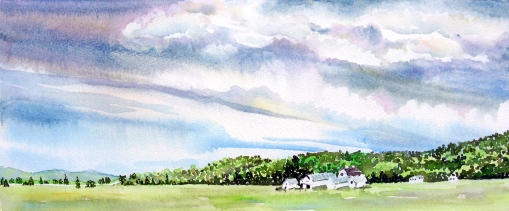I was really sad to see this class end. The group worked so well together, learning from each other, asking questions, and eager to learn more. They always had assignments done, and often did two paintings.
Exploring Watercolor is the class we offer that gets the artist started with watercolor.
Here are examples of some of the things we do:

Todd Dunn5
The first night is devoted to introducing the different brushes and their uses, the palette and how to set it up. They learn wet-in-wet, wet on dry and dry brushing applications and we talk about how to make convincing and rich darks by using mixtures of dark colors rather than rushing to neutral tint or just paynes gray and ending up with a flat dark. The above painting shows darks created with mixtures of colors and has evidence of the three different ways to apply watercolor.

Lorri Medaugh5
I also ask them to paint a backlit painting the first week. This gets them working with their darks from the beginning. It has been my experience that artists first bridge to cross is getting that contrast between light and dark. In watercolor, many artists fear getting dark too fast. One of my students chose a back-lit photo of hers that she had taken on vacation of a back-lit koi pond. I really liked the abstract quality of this. Note how her darks are washes of several colors mixing together on the paper.

Linda Flatley4 Analagous

Beth Akey 4 Complimentary

Alan Pareis5 Primary
The next week we learned about color and which ones were opaque and which were more transparent. We discussed color combinations and identified them on the color wheel. They all designed their paintings this week to a chosen color combination.
We also began practicing softening an edge and learned the difference between a hard and soft edge.

Alan Pareis2

Lorri Medaugh4
The next week was all about trees and how to paint them. We talked about using a liner or rigger to create the tiny branches. We learned how to use a sponge and frisket, about pointillism and scumbling, dropping salt and splattering; all to create textural effects in our trees. Every painting these students brought in was fresh and new and they all brought their own take to the scene they created.

Susie Covitt5

Todd Dunn4
During the fourth week we painted studies of clouds, skies and water. What fun when they learned about tissue paper and lifting wet paint and swiping with a sponge or making wax resist clouds and frisketed foam on water. They were able to use their skill of softening an edge in these, also. We talked about how to paint reflections in water and how to save the white of moon or sun and soften around the edges of the sun.

Susie Covitt2

Linda Flatley2
During the fifth week we practiced painting “little people” described before here and here. They learned simple dimensions of the human form, how to allow the colors to run together and how to ground them into the surface they were standing on by running a shadow off of them.

Beth Akey
The last night of the class, we touched on buildings and how they are man-made shapes clustered together and that they cast shadows. They provide contrast with the surrounding natural forms.
Thank you to all of you who took this class and were willing to share your work, here, on this blog, for others to see. If you would like to see more of their work click here or scroll to the top of this page and click on Student Art: Exploring Watercolor.







































